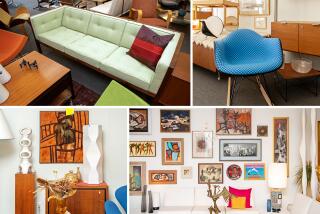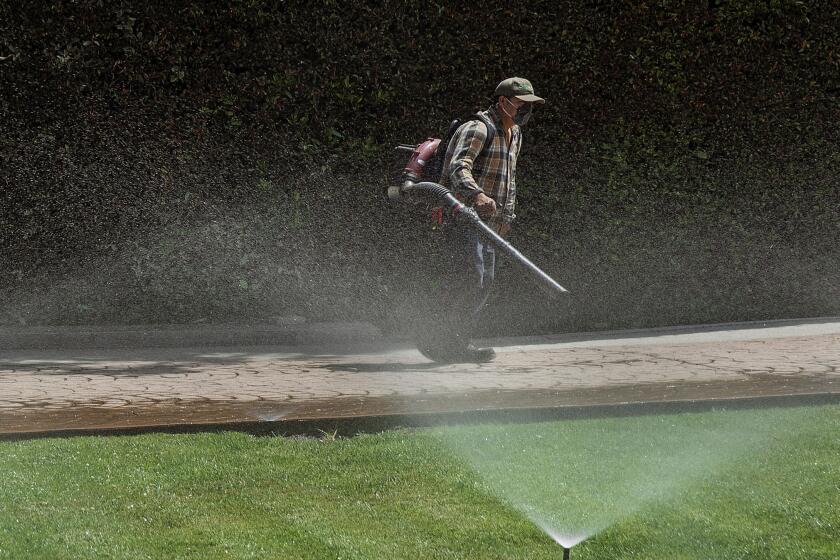When Houseplants First Took Root
- Share via
Gardens and houseplants have always been an important part of the 18th and 19th century home. In the 18th century, a homeowner would plant a garden with medicinal and cooking herbs. Many gardens had some of the same flowers we plant today for enjoyment.
In areas with mild winters, some plants were potted and moved inside, even though their care was more complicated than it is today. There were no bug sprays, no prepared potting soils, no special plant foods. But the 19th century housewife prided herself on her plants, and plants were kept on window ledges, plant stands and terrariums in suitable windows.
Bulbs that could be forced to bloom in the winter were especially popular.
Many of the plant stands and baskets were made in a rustic style with parts that resembled trees and leaves. Potted plants, especially palms and ferns, were part of the decoration of a middle-class Victorian home. The plant room had trailing vines and tall plants that were kept together in a jungle-like atmosphere.
Today, plants are easy to buy and even easier to grow. Collectors buy all types of plant stands, vases and accessories. But when a rare majolica jardiniere on a stand rises in value to thousands of dollars, the collector is forced to decide whether it is worth the risk of damage by filling it with plants.
*
Question: When were Wade figurines first made?
*
Answer: Wade potteries started in 1810 in Burslem, England. Many members of the Wade family made pottery, and after a number of years their companies merged and formed several larger, new potteries.
In 1935, the two biggest companies--Wade Heath & Co. and A.J. Wade--joined. They later joined George Wade & Son Ltd. and Wade Ltd.
In the early 1950s, the Wades all became the Wade Group of Potteries Ltd. In the late 1950s, the company started to make “Wade Whimsies,” a series of miniature animals. The company has changed ownership several times and is now part of Beauford PLC. The Red Rose Tea Co. of Canada has used Wade figures as premiums since 1981.
*
Q My grandmother was born in 1890. She left me a beautiful table lamp with a metal base and a reverse-painted glass shade. The picture painted on the inside of the shade shows the sky at sunset with clouds, mountains and trees. The colors used are brown rust, gold, yellow, blue and green. Inside the lower rim of the shade I found a mark that reads “The Pairpoint Corp’n.” I have had the lamp rewired, but otherwise it is original. Can you tell me when and where it was made?
*
A The Pairpoint Manufacturing Co. of New Bedford, Mass., was founded in 1880. It made only silver products until 1894, when it was taken over by the Mt. Washington Glass Co. In 1900, the company was reorganized as the Pairpoint Co. Pairpoint made lamps with glass shades between about 1907 and 1929. There were three styles of reverse-painted shades--puffy, ribbed and scenic. Yours is a scenic shade.
*
Q My small piano (68 keys) is marked “Winter, New York.” Can you give me some information about it?
*
A Your piano is called a “pianette.” It was designed for use in a small room or apartment.
Julius Winter was born in Hungary in 1856. He bought Heller and Co., a New York City piano-manufacturing business, sometime between 1901 and 1903. He renamed the company, expanded the factory and eventually controlled several brand names, including “Pianette.”
Winter and Co. is best known for its introduction of the spinet piano in 1935. The company was later bought by Aeolian Corp. If you can read the serial number on your piano, you can determine its age by checking in a piano atlas. Piano atlases can be found in most libraries or online.
*
Q I purchased a Jacquard coverlet at a yard sale. It is woven in red, yellow and black and measures 70 by 84 inches. It is made of two pieces woven together. The corners read, “Columbia NA 1837.” The design includes roses surrounded by a border of birds. The fringe has worn off. Can you tell me more about it?
*
A The Jacquard loom was invented in France. It allowed weavers to create complicated patterns using mechanical looms. Jacquard looms were used in the United States from the 1820s to the 1880s. Two of the many “stock” patterns were the Double Rose and the Bird border. Both were used on your coverlet.
The word Columbia might refer to the city or county where the weaver’s customer lived. “NA” could be the customer’s initials. Original 19th century Jacquard coverlets sell from $300 to more than $2,000, depending on the condition and size.
*
Q My pack of cigarettes is so old it does not have the warning on the side that says smoking is dangerous. When was that wording added?
*
A The warning label was first used in January 1966.
For a list of helpful books and publications, include a self-addressed, stamped (55 cents) envelope to Kovels, Los Angeles Times, King Features Syndicate, 235 E. 45th St., New York, NY 10017.
Current Prices
Figures are recorded from antique shows, flea markets, sales and auctions throughout the United States. Prices vary according to local economic conditions.
* John F. Kennedy paperweight, sulfide, etched floral design, impressed “Butler,” 3 1/4 inches, $60.
* Franciscan platter, apple pattern, 12 1/2 inches, $70.
* Occupied Japan figurine, fish bowl, hanging cat, white with brown stripes, 1940s, $110.
* Yves St. Laurent rhinestone shoes, high heel, ankle strap, 1970, size 7, $155.
* Sewing box, mahogany and lithographed paper, rectangular, marbleized paper interior, compartments, New York, 1830, 3 by 10 by 7 inches, $220.
* Harley Davidson alarm clock, image of soldier on motorcycle at 9 o’clock, “Buy War Bonds” logo at 2 o’clock, 1940s, 4 1/2 by 2 1/2 by 4 1/2 inches, $240.
* Loetz art-glass vase, oval, iridescent gold swirled design, blue and purple highlights, circa 1902, 5 1/2 inches, $460.
* Victorian mastic earrings, rectangular plaque, silver, accented by a beaded frame, bouquet of tricolored mosaic flowers, c. 1890, $575.
* Madame Alexander doll, ballerina, coil-braided hair, composition body, original clothing, circa 1948, 17 1/2 inches, $690.
* Ironstone soup tureen, Rambling Rose pattern, lily pad knop, 1850, 14 inches, $1,500.






